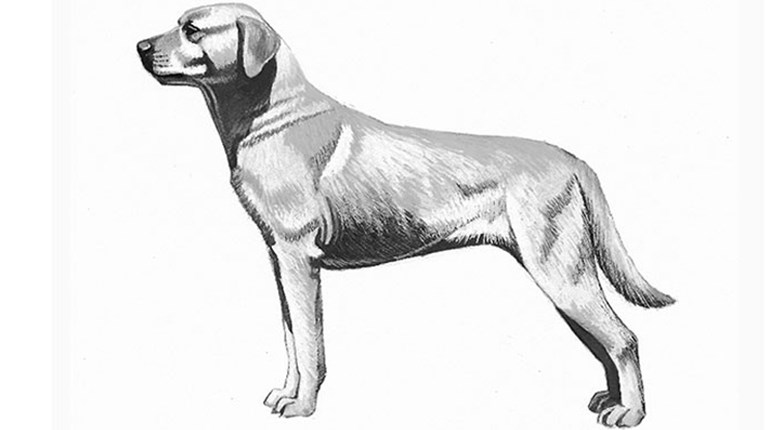A 2-year-old English springer spaniel, Pirogue powerfully courses the field, blasting through thorns and thick brush in classic upland breed fashion. He works the area in a back-and-forth, quartering manner—leaving no grass unturned—as dictated by a century of instilled hunting instinct. His sire was a national high point champion in American springer field trials; his mother, a pheasant dog descended from British lines. And so Pirogue’s inherited prey drive pushes him to find his quarry. He catches the scent, throws his head upwind and makes a small circle to zero in. Then he sits down and barks, announcing he’s found the intended target: a set of 200-year-old human bones, planted earlier by a search-and-rescue instructor.
You see, Pirogue is not a bird-hunting dog. Arguably he’s something far greater: one of an increasing number of spaniels and other hunting dogs being trained for search-and-rescue operations, bomb sniffing, narcotics detection and more. Here’s why they are so well suited to these important tasks.
British Military Tradition
While the use of springers is a relatively new phenomenon in U.S. circles—where the German shepherd, malinois and other larger breeds dominate—it is one of the most popular breeds serving the British military. Springers may lack the size required for combatting enemies, but the British feel there’s no better choice for sniffing out explosives and aiding the recovery of wounded or missing troops.
Most recently, two springers received Britain’s Dickin Medal, an award for animal valor. One went to a dog named Buster in 2003 after he discovered a major weapons cache hidden by Iraqi insurgents. Buster was considered so valuable that he wore his own gas mask and other protective gear. Another springer, Theo, was honored with the medal in 2012. Theo and his handler, Lance Cpl. William Tasker, set a British record for most bomb finds while serving in Afghanistan. Sadly, the medal was delivered posthumously: Tasker was killed in action in 2011, and three hours later Theo suffered a fatal, presumably stress-induced seizure.
Though spaniels have seen only limited use by the U.S. military, Americans have begun to take note of the springer’s potential in these regards. Kathy Chiodo, whose Chiodo Kennels churns out some of the country’s best service dogs, spent a year in Afghanistan and Iraq assisting U.S. forces with search-and-rescue efforts.
“I spent two weeks at Camp Leatherneck, a Marine Corps base in Afghanistan, and the British kennels were right next door,” she recalls. “Their springers were real sweethearts, biddable and eager to please. But what most impressed me was their endurance in the extreme heat—there was just no quit in them. Some of the larger breeds overheated far more quickly. The spaniel’s size offers other advantages as well. It easily fits inside a cramped Humvee or helicopter, and it can search a lot of little pockets in the rubble for explosives or victims that bigger dogs tend to pass over.”
When Chiodo returned home to Philippi, W.Va., she promptly purchased a male springer with a bird-hunting pedigree. It’s now a narcotics-detection dog for a police department in California.
Called to Duty
It’s difficult to quantify exactly how many field-bred dogs are now serving in law-enforcement and related roles, but Chiodo believes it’s certainly on the rise.
“Especially since [the Sept. 11 terrorist attacks], most of the best shepherds started going to contract agencies and the military, so there was a berth of good hunting-type dogs to fill that void,” she says. “Springers are high on the list, but I’ve seen many highly skilled German shorthairs as well. A friend who trains and breeds search-and-rescue dogs in Maryland uses them exclusively.”
Chiodo additionally credits field dogs’ healthy genetics for the increased demand.
“So many breeds are prone to hip, elbow, thyroid and glycogen-storage problems, but healthy field dogs are easier to come by,” she says. “The bloodhound, for example, increasingly has an unhealthy genetic mix, so many are moving to the various coonhound breeds for tracking work. They’re excellent trailing dogs and have a healthy background.”
Chiodo did, however, offer a sobering take on one of history’s most popular sporting breeds, a dog used for everything from tracking work to physically nabbing bad guys: the Labrador retriever.
“Along with German shepherds, it’s still one of the top breeds, but health issues are starting to affect it,” Chiodo says. “We used to go to shelters, and if they had a Lab we wouldn’t even screen it—we’d just take it—but now we wouldn’t consider that. A lot of people aren’t breeding them for work, they’re just breeding them, and it’s affecting their genes.”
Still, a good Lab is hard to beat.
“They’re just so forgiving of new handlers’ mistakes, whereas a German shepherd might say, ‘I’ll give you one more minute to quit jerking me around or we’re going to dance,’” Chiodo says. “Few dogs can match the Lab’s skill overall. A friend in Colorado recently did a hunt for historical graves with her cadaver Labs, and they found 200- to 300-year-old graves that many other dogs missed.”
 Law Enforcement
Law Enforcement
Forty-pound spaniels can’t be expected to drag carjackers to the ground, but they’re proving their mettle as K-9 units in the detection of narcotics, explosives and other threats. In a decade-long trend, many police agencies are adding springers to the force, including the George Mason University Police Department in Fairfax, Va., which acquired one earlier this year.
“We had the opportunity to select a dog from an explosive-ordnance detection class that included four springers and traditional breeds like German shepherds and malinoises,” explained Master Police Officer John Arnold. “During the class, the springers just found the bombs more easily and more quickly than the others. Their prey drive and hunting instinct is really incredible, and I think that’s why they succeed. Their desire to find birds translates really well to finding explosives.”
Arnold chose a liver-and-white female named Lucy.
“She’s been a really great addition,” Arnold says. “Lucy’s able to sniff out bombs, shell casings, ditched guns and even trace evidence of arsons. Plus, her endurance is really impressive. We were at a training event today and she was still going strong when the shepherds needed a rest.”
Lucy’s training was put to the test during a recent bomb threat. When a suspect was led from his room he revealed Pyrodex, which was removed. Then Arnold sent in the dog to search the building.
“In no time she alerted us to previous presence of the Pyrodex,” Arnold says. “Lucy kept a lot of people safe that day.”
According to Chiodo, a small, stamina-rich dog like Lucy is the ideal choice for such a scenario.
“There aren’t many dogs trained for bomb detection, so when a threat is called in it’s generally just one handler and a dog,” she notes. “So, for example, if a threat is called in at a school, you have this big area to search and you need to do it quickly. A small dog with a ton of endurance and drive can make all the difference.”
Lucy has also paid off in unexpected ways.
“She’s a small, friendly dog that’s perceived as a lot less threatening than some breeds,” Arnold says. “She’s been a comfort to kids or people we come into contact with who are in distressing situations.”
For similar reasons, the Transportation Security Administration, various train stations and cruise lines have begun to employ yellow Labs, golden retrievers and spaniels for narcotics and explosives detection. Travelers tend to feel more at ease in their presence compared to, say, a big, intimidating German shepherd.
Search-and-Rescue Gundogs
Many municipalities lack the financial resources to staff search-and-rescue crews. So, to locate missing persons and homicide victims, law enforcement and fire-rescue teams rely on volunteer groups and their dogs. Groups like Gulf Coast Search and Rescue in Saucier, Miss., are populated by members like Claire Sluyterman van Loo and her springer, Pirogue, as well as a Lab, coonhound and other breeds like beagles.
“From what I understand, Pirogue’s sire excelled in field trials because he was tough and would bust through cover others wouldn’t,” says Sluyterman van Loo, who expects Pirogue to be a certified cadaver-search dog by summer’s end. “And that’s what makes Pirogue such a special search dog: He’ll go in any culvert, body of water, old building or wrecked car—all with a smile on his face. Nothing fazes him, and that’s a big part of what makes a good search-and-rescue dog.”
The instinctive, zig-zagging pattern inherent in upland breeds makes them a natural choice for such missions.
“Some breeds need their trainer to slowly walk them around the search area,” says Pirogue’s owner. “But the bird dogs get out and work the grid ahead of you, accepting guidance when necessary just like when they’re hunting birds. They quickly and thoroughly cover a lot of ground. Everybody who sees Pirogue run says, ‘There goes a bird dog,’ because they recognize the running pattern.”
In training, Pirogue has run inside a mobile home to find an 8-year-old bloody T-shirt—which he apparently scented from outside—and even climbed three trees to find human scent. What drives him?
“It’s common knowledge that a good hunting dog with a strong nose generally makes a good search-and-rescue dog,” Sluyterman van Loo says. “Whether hunting birds or human remains, their prey drive pushes them to excel. Pirogue loves his job.”
Drawbacks to Field Dogs
Sluyterman van Loo and Chiodo purchased dogs from Salmy Acres Kennel in Kearneysville, W.Va., where some of the country’s top field-bred springers are produced.
“I’m a veteran, so I thought the idea of selling dogs for service to the country was pretty cool,” says owner Mike Wallace. “Gundogs don’t necessarily need to hunt to be happy, but they need a job to keep them busy.”
However, unlike with many breeds, dedicated efforts have not been in place to tailor most hunting dogs to such roles. There were bound to be drawbacks, and Wallace and Chiodo note that some spaniels have proven too soft for intense situations.
“Many of them lack what we call ‘nerve strength,’” Chiodo says. “I’ve seen pointers and spaniels that are fine around gunfire, but in an extremely hectic environment such as traffic or a lumber mill they start to break down. It’s subtle with the springers, because their desire to please is so great that they push on despite their fear, but you notice little things like stress yawning. And if you’re overseas in a war zone, the last thing you want is your dog to break down.”
Therefore if you’re interested in volunteering for a search-and-rescue group with your dog, Chiodo advises a simple nerve-strength test before moving forward.
“Take the dog somewhere with a lot of action, clanging and noises,” she advises. “Watch for yawning and other signs of fear. Unfortunately, if you notice it, it’s not really something you can break them of. It’s an inherited personality trait, and a key failing I see in springers and some hunting breeds.”
That’s not the dogs’ fault—they were bred to hunt, not to find bombs. However, if they continue gaining popularity for such purposes, Chiodo says careful breeding can strengthen their nerves.
“Breeders can learn to test for nerve strength in puppies,” Chiodo says. “I’ve seen it vastly improve in as few as three generations.”
So, while our cherished hunting breeds aren’t likely to put the German shepherd out of business anytime soon, they’re doing much to serve the country. From sniffing out bombs and drugs to locating wounded soldiers, their powerful noses, desire to please, and old fashioned hunting instincts are proving to be assets at home and abroad.





































